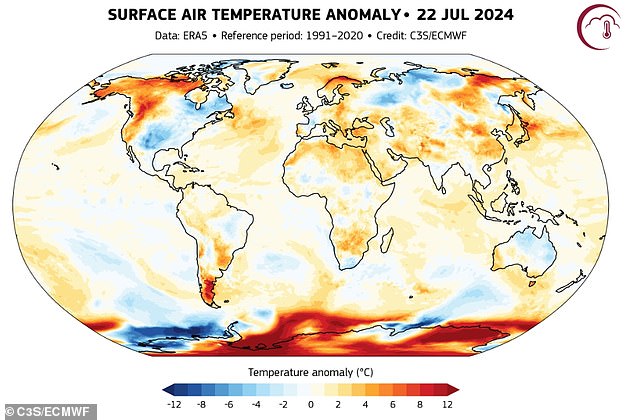Just one day after scientists announced that Sunday was the hottest day on Earth, we already have a new record.
Monday (22 July) is now the warmest day on record in the planet’s history, according to experts from the EU climate change programme.
Monday’s global average temperature was 17.15 °C (62.87 °F), 0.06 °C (0.1 °F) warmer than Sunday, which recorded a global average of 17.09 °C (62.76 °F).
And there’s a good chance that when Tuesday’s data comes in, it will be three straight days of record-breaking heat globally.
Experts point to the fossil fuel industry, which emits greenhouse gases such as CO2 and methane by burning fossil fuels like coal, gas and oil.
This map shows where Earth experienced heat extremes on July 22, the hottest day on Earth, compared to the 1991-2020 baseline period.
Carlo Buontempo, director of the European climate service Copernicus (CS3), explained that “these peaks are usually not isolated.”
“The climate in general is warming as a result of increasing greenhouse gases,” he said.
The two consecutive records are due to abnormally warm oceans, as well as higher-than-normal temperatures in Antarctica, the western United States and Canada, and eastern Siberia.
At the same time, Europe has suffered its own deadly heatwave, with wildfires in Greece and Croatia more common in dry conditions.
Buontempo said the high temperatures of recent days are consistent with the idea that man-made climate change is accelerating, but it is too early to draw that conclusion.
“It could be the first sign of a change in the pace of temperature increase,” he said.
We already know that June 2024 was the thirteenth consecutive month with record heat.
In other words, every month since June 2023 has been the warmest on record for that particular month, indicating an ongoing warming trend.
“What’s really amazing is how big the difference is between the temperature of the last 13 months and previous temperature records,” Buontempo said earlier this week.

A man cools off during a heatwave in Provence, Var, in Hyères, France, July 22, 2024

This chart shows the hottest days of the year for each year since 1974. Notice how the last 10 years have been much higher, compared to before the turn of the century.
‘We are now in truly uncharted territory and as the climate continues to warm, we are sure to see new records in the months and years ahead.’
Berkeley Earth climate scientist Dr. Zeke Hausfather now estimates there is a 92 percent chance that 2024 will surpass 2023 as the warmest year on record.
“It’s certainly a worrying sign coming after 13 consecutive months of record-breaking growth,” he said.
Climate scientists say this could be the warmest period in 120,000 years due to human-caused climate change.
However, it is not possible to be certain whether Monday was the warmest day in that period because CS3 records only go back to 1940.
“For most of the last 120,000 years we were in an ice age and today it’s clearly warmer than that,” said Texas A&M University climate scientist Andrew Dessler.
According to the academic, studies indicate that we are in the hottest period of the last 10,000 years.

A boy with a water gun plays in a fountain on July 22, 2024 in Tokyo, Japan. Japan’s government continues to issue heat stroke warnings in 40 of the country’s 47 prefectures, including Tokyo.

Crowds on the beach at the seaside resort of Lyme Regis in Dorset, England, on July 22, 2024, the hottest day on earth
Roxy Mathew Koll, a climate scientist at the Indian Institute of Tropical Meteorology, stressed that such records can kill people.
“We are in an era where weather and climate records often exceed our tolerance levels, resulting in insurmountable losses of life and livelihoods,” he said.
C3S, managed by the European Commission, analyses temperature readings based on a variety of platforms and instruments, from weather stations to weather balloons and satellites.
The department’s readings refer to the average air temperature for the entire planet over the entire year, meaning they are lower than a single, typically “warm” temperature reading.
Social media commentators were outraged by the announcement that June was the hottest month on record, with one saying “we had the heating on”.
But CS3 doesn’t just focus on the UK or any specific region; it looks at the whole planet.
Looking at the UK alone, Friday was the hottest day of the year so far, according to the Met Office, while 2023 was the second-warmest year since records began in 1884.


